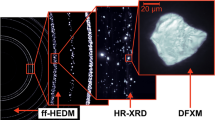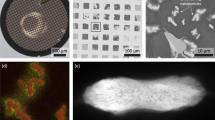Abstract
The advent of nanosciences calls for the development of local structural probes, in particular to characterize ill-ordered or heterogeneous materials. Furthermore, because materials properties are often related to their heterogeneity and the hierarchical arrangement of their structure, different structural probes covering a wide range of scales are required1,2,3,4,5,6,7,8,9,10,11,12,13,14,15,16,17,18,19,20,21,22,23. X-ray diffraction is one of the prime structural methods but suffers from a relatively poor detection limit, whereas transmission electron analysis involves destructive sample preparation. Here we show the potential of coupling pencil-beam tomography with X-ray diffraction to examine unidentified phases in nanomaterials and polycrystalline materials. The demonstration is carried out on a high-pressure pellet containing several carbon phases24 and on a heterogeneous powder containing chalcedony and iron pigments. The present method enables a non-invasive structural refinement with a weight sensitivity of one part per thousand. It enables the extraction of the scattering patterns of amorphous and crystalline compounds with similar atomic densities and compositions. Furthermore, such a diffraction-tomography experiment can be carried out simultaneously with X-ray fluorescence, Compton and absorption tomographies6, enabling a multimodal analysis of prime importance in materials science, chemistry, geology, environmental science, medical science, palaeontology and cultural heritage.
This is a preview of subscription content, access via your institution
Access options
Subscribe to this journal
Receive 12 print issues and online access
$259.00 per year
only $21.58 per issue
Buy this article
- Purchase on Springer Link
- Instant access to full article PDF
Prices may be subject to local taxes which are calculated during checkout




Similar content being viewed by others
References
Manceau, A. et al. Deciphering Ni sequestration in soil ferromanganese nodules by combining X-ray fluorescence, absorption, and diffraction at micrometer scales of resolution. Am. Mineral. 87, 1494–1499 (2002).
Dooryhée, E. et al. Non-destructive synchrotron X-ray diffraction mapping of a Roman painting. Appl. Phys. A 81, 663–667 (2005).
Welcomme, E. et al. Classification of lead white pigments using synchrotron radiation micro X-ray diffraction. Appl. Phys. A 89, 825–832 (2007).
Harding, G., Kosanetsky, J. & Neitzel, U. Elastic scatter computed tomography. Phys. Med. Biol. 30, 183–186 (1985).
Harding, G., Kosanetsky, J. & Neitzel, U. X-ray diffraction computed tomography. Med. Phys. 14, 515–525 (1987).
Kleuker, U., Suortti, P., Weyrich, W. & Spanne, P. Feasibility study of x-ray diffraction computed tomography for medical imaging. Phys. Med. Biol. 43, 2911–2923 (1998).
Cloetens, P. et al. Holotomography: Quantitative phase tomography with micrometer resolution using hard synchrotron radiation x rays. Appl. Phys. Lett. 75, 2912–2914 (1999).
Golosio, B. et al. Nondestructive three-dimensional elemental microanalysis by combined helical x-ray microtomographies. Appl. Phys. Lett. 84, 2199–2201 (2003).
Kim, S. A. et al. Localization of iron in arabidopsis seed requires the vacuolar membrane transporter VIT1. Science 314, 1295–1298 (2006).
Larivière, P. J. & Vargas, P. A. Monotonic penalized-likelihood image reconstruction for X-ray fluorescence computed tomography. IEEE Trans. Med. Imaging 25, 1117–1129 (2006).
Schroer, C. G. Reconstructing x-ray fluorescence microtomograms. Appl. Phys. Lett. 79, 1912–1914 (2001).
Golosio, B., Brunetti, A. & Cesaero, R. Algorithmic techniques for quantitative Compton tomography. Nucl. Instrum. Methods B 213, 108–111 (2004).
Schroer, C. G. et al. Mapping the local nanostructure inside a specimen by tomographic small-angle x-ray scattering. Appl. Phys. Lett. 88, 164102 (2006).
Nielsen, S. F. et al. A conical slit for three-dimensional XRD mapping. J. Synchrotron Radiat. 7, 103–109 (2000).
Poulsen, H. F., Jensen, D. J. & Vaughan, G. B. M. Three-dimensional X-ray diffraction microscopy using high-energy X-rays. Mater. Res. 29, 166–169 (2004).
Tamura, N. et al. High spatial resolution grain orientation and strain mapping in thin films using polychromatic submicron x-ray diffraction. Appl. Phys. Lett. 80, 3724–3726 (2002).
Budai, J. D. et al. X-ray microdiffraction study of growth modes and crystallographic tilts in oxide films on metal substrates. Nature Mater. 2, 487–492 (2003).
Larson, B. C., Yang, W., Ice, G. E., Budai, J. D. & Tischler, J. Z. Three-dimensional X-ray structural microscopy with submicrometre resolution. Nature 415, 887–890 (2002).
Ludwig, W. et al. Three-dimensional imaging of crystal defects by ‘topo-tomography’. J. Appl. Cryst. 34, 602–607 (2001).
Ludwig, W., Lauridsen, E. M., Schmidt, S., Poulsen, H. F. & Baruchel, J. High-resolution three-dimensional mapping of individual grains in polycrystals by topotomography. J. Appl. Cryst. 40, 905–911 (2007).
Miao, J. et al. Three-dimensional GaN–Ga2O3 core shell structure revealed by X-ray diffraction microscopy. Phys. Rev. Lett. 97, 215503 (2006).
Pfeifer, M. A. et al. Three-dimensional mapping of a deformation field inside a nanocrystal. Nature 442, 63–66 (2006).
Miao, J., Ishikawa, T., Shen, Q. & Earnest, T. Extending the methodology of X-ray crystallography to allow structure determination of non-crystalline materials, whole cells and single macromolecular complexes (invited review). Annu. Rev. Phys. Chem. 59, 24–27 (2008).
Nunez-Regueiro, M., Monceau, P. & Hodeau, J.-L. Crushing C60 to diamond at room temperature. Nature 355, 237–239 (1992).
Hodeau, J.-L. et al. High-pressure transformations of C60 to diamond and s p3 phases at room temperature and to s p2 phases at high temperature. Phys. Rev. B 50, 10311–10314 (1994).
Marques, L. et al. Debye–Scherrer ellipses from 3D fullerene polymers: An anisotropic pressure memory signature. Science 283, 1720–1723 (1999).
Sole, V. A., Papillon, E., Cotte, M., Walter, P. & Susini, J. A multiplatform code for the analysis of energy-dispersive X-ray fluorescence spectra. Spectrochim. Acta B 62, 63–68 (2007).
Pouget, E. et al. Hierarchical architectures by synergy between dynamical template self-assembly and biomineralization. Nature Mater. 6, 434–439 (2007).
Natterer, F. & Wübbeling, F. Mathematical Methods in Image Reconstruction 110 (SIAM, Philadelphia, 2001).
Somogyi, A. et al. ID22: A multitechnique hard X-ray microprobe beamline at the European Synchrotron Radiation Facility. J. Synchrotron Radiat. 12, 208–215 (2004).
Etherington, G., Wright, A. C. & Wenzel, J. T. A neutron-diffraction study of the structure of evaporated amorphous-germanium. J. Non-Cryst. Solids 48, 265–278 (1982).
Wright, A. C. et al. The structure of some simple amorphous network solids revisited. J. Non-Cryst. Solids 129, 213–232 (1991).
Labiche, J.-C. et al. The fast readout low noise camera as a versatile x-ray detector for time resolved dispersive extended x-ray absorption fine structure and diffraction studies of dynamic problems in materials science, chemistry, and catalysis. Rev. Sci. Instrum. 78, 091301 (2007).
Acknowledgements
We wish to thank M. Nunez-Regueiro and L. Marques for sample synthesis, discussions and suggestions. The authors are also grateful to R. Tucoulou, S. Labouré, C. Guilloud, M. Soulier, Y. Dabin, C. Nemoz, J.-C. Labiche, A. Sole and the support groups of the ESRF for their help during experiments. This study was funded by grants from ESRF (LTP CH-1777).
Author information
Authors and Affiliations
Corresponding author
Rights and permissions
About this article
Cite this article
Bleuet, P., Welcomme, E., Dooryhée, E. et al. Probing the structure of heterogeneous diluted materials by diffraction tomography. Nature Mater 7, 468–472 (2008). https://doi.org/10.1038/nmat2168
Received:
Accepted:
Published:
Issue Date:
DOI: https://doi.org/10.1038/nmat2168
This article is cited by
-
A New Residual Strain Mapping Program Using Energy Dispersive X-Ray Diffraction at the Advanced Photon Source
Experimental Mechanics (2022)
-
Deep denoising for multi-dimensional synchrotron X-ray tomography without high-quality reference data
Scientific Reports (2021)
-
Spatial quantification of dynamic inter and intra particle crystallographic heterogeneities within lithium ion electrodes
Nature Communications (2020)
-
Neutron visualization of inhomogeneous buried interfaces in thin films
Scientific Reports (2019)
-
Design of next-generation ceramic fuel cells and real-time characterization with synchrotron X-ray diffraction computed tomography
Nature Communications (2019)



